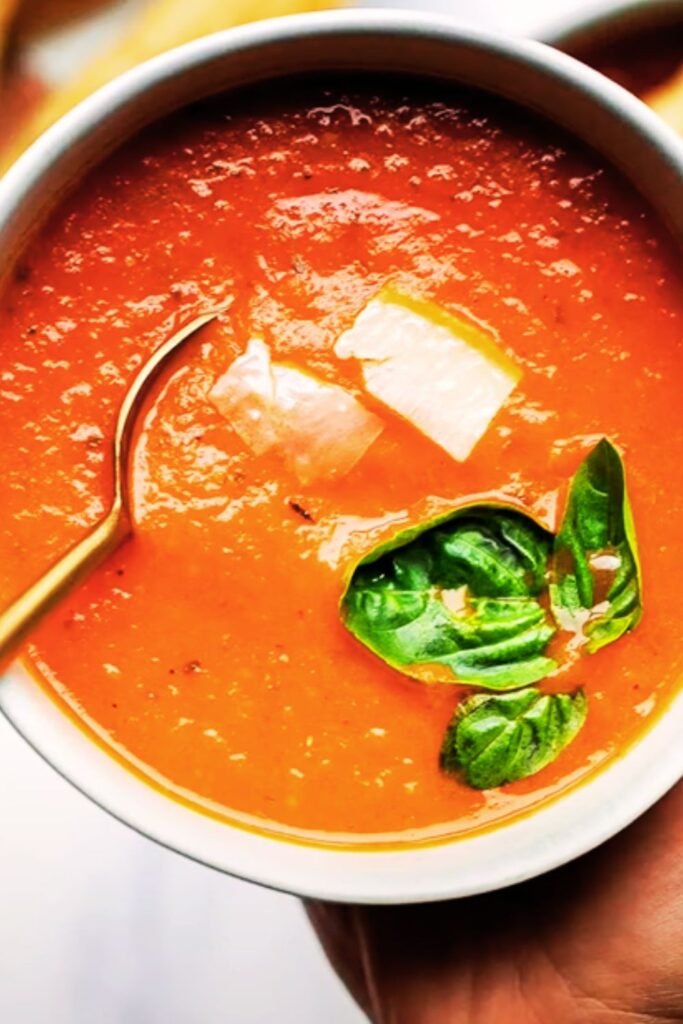There’s something magical that happens when tomatoes meet the dry heat of an oven. I’ve been perfecting my roasted tomato basil soup recipe for over a decade, and I can honestly say it’s transformed my understanding of what soup can be. Unlike the canned varieties that dominated my childhood, this homemade version delivers layers of complex flavor that only come from properly roasted vegetables and fresh herbs.
My journey with this soup began during a particularly abundant tomato harvest from my garden. I had more ripe tomatoes than I knew what to do with, and the thought of letting them go to waste felt criminal. That’s when I discovered the transformative power of roasting – it concentrates the tomatoes’ natural sugars, deepens their flavor, and creates a soup base that’s both rich and surprisingly light.
Why Roasting Makes All the Difference
When I first started making tomato soup, I followed traditional methods that called for sautéing fresh tomatoes in a pot. While those soups were decent, they lacked the depth I craved. Roasting changes everything. The high heat caramelizes the natural sugars in the tomatoes, creating those beautiful brown edges that translate into incredible flavor complexity.
The roasting process also removes excess water from the tomatoes naturally, which means my soup has a more concentrated taste without requiring hours of simmering to reduce. I’ve found that roasting at 425°F for about 35-40 minutes gives me the perfect balance of caramelization and moisture retention.
Key Ingredients and Their Roles
Fresh Tomatoes: The foundation of any great tomato soup
- Roma tomatoes: My preferred choice for their lower water content and robust flavor
- Vine-ripened tomatoes: Excellent for peak season cooking
- Cherry tomatoes: Add natural sweetness when mixed with larger varieties
Fresh Basil: The aromatic partner that elevates everything
- Sweet basil: The classic choice with its peppery, slightly minty notes
- Purple basil: Adds visual interest and a more intense flavor
- Thai basil: For those who want a subtle licorice note
Aromatics: Building the flavor foundation
- Yellow onions: Provide sweetness and depth
- Garlic: Essential for that savory backbone
- Carrots: Add natural sweetness and body to the soup
Essential Equipment for Perfect Results
| Equipment | Purpose | My Recommendation |
|---|---|---|
| Large rimmed baking sheet | Even roasting of vegetables | Use heavy-duty aluminum or stainless steel |
| High-powered blender | Smooth, velvety texture | Vitamix or similar immersion blender |
| Heavy-bottomed pot | Even heating for simmering | Enameled cast iron or stainless steel |
| Fine-mesh strainer | Removing seeds and skin bits | Optional for ultra-smooth consistency |
| Sharp chef’s knife | Clean cuts for even cooking | 8-inch blade minimum |
My Perfected Recipe
Ingredients for 6-8 Servings
For Roasting:
- 4 pounds mixed fresh tomatoes, halved
- 1 large yellow onion, quartered
- 6 garlic cloves, peeled
- 2 medium carrots, chopped into 2-inch pieces
- 3 tablespoons extra virgin olive oil
- 2 teaspoons kosher salt
- 1 teaspoon freshly ground black pepper
For the Soup Base:
- 4 cups low-sodium vegetable broth
- 1 cup whole milk or heavy cream
- 1/4 cup packed fresh basil leaves
- 2 tablespoons tomato paste
- 1 tablespoon sugar (optional, for balancing acidity)
- 1 teaspoon dried oregano
- Salt and pepper to taste
For Garnish:
- Fresh basil leaves
- A drizzle of good olive oil
- Freshly grated Parmesan cheese
- Homemade croutons

Step-by-Step Instructions
Preparation Phase:
- I always start by preheating my oven to 425°F. This high temperature is crucial for proper caramelization.
- While the oven heats, I prepare my vegetables. The tomatoes get halved (I remove the cores but leave the seeds – they add flavor), onions are quartered, carrots chopped into uniform pieces, and garlic cloves peeled but left whole.
- On my largest rimmed baking sheet, I arrange all the vegetables in a single layer. Overcrowding leads to steaming rather than roasting, which defeats the purpose.
The Roasting Process:
- I drizzle everything generously with olive oil – about 3 tablespoons total – then season with salt and pepper. Using my hands, I toss everything to ensure even coating.
- Into the oven they go for 35-40 minutes. I’m looking for beautifully caramelized edges and some charred spots. The vegetables should be tender and aromatic.
- About halfway through, I give the pan a shake to ensure even browning. The smell that fills my kitchen during this process never gets old.
Building the Soup:
- Once roasted, I let the vegetables cool slightly before transferring them to my blender. I add about 2 cups of the vegetable broth first – this helps the blending process.
- I blend in batches if necessary, processing until completely smooth. The texture should be velvety, not chunky.
- In my heavy-bottomed pot, I combine the blended mixture with the remaining broth, tomato paste, and dried oregano. I bring this to a gentle simmer over medium heat.
- After simmering for 15 minutes, I add the milk or cream and fresh basil. The dairy goes in last to prevent curdling.
- Using my immersion blender, I give everything one final blend to incorporate the cream and basil completely.

Flavor Balancing and Seasoning
This is where experience really matters. I taste the soup and adjust accordingly:
- Too acidic? A teaspoon of sugar or a splash more cream helps
- Lacking depth? More salt or a splash of balsamic vinegar
- Not herby enough? Fresh basil stirred in at the end
- Too thin? Simmer uncovered to reduce, or add more tomato paste
- Too thick? Thin with additional broth
Nutritional Profile and Health Benefits
| Nutrient | Per Serving (1 cup) | % Daily Value |
|---|---|---|
| Calories | 165 | 8% |
| Protein | 6g | 12% |
| Carbohydrates | 18g | 6% |
| Fiber | 4g | 16% |
| Vitamin C | 28mg | 31% |
| Vitamin A | 1,250 IU | 25% |
| Potassium | 650mg | 19% |
| Lycopene | 12mg | N/A |
The nutritional benefits of this soup extend far beyond basic vitamins. The lycopene in roasted tomatoes is actually more bioavailable than in raw tomatoes, making this soup a powerhouse of antioxidants. I’ve found that the combination of healthy fats from olive oil and the natural compounds in basil creates a synergistic effect that enhances nutrient absorption.
Storage and Make-Ahead Tips
One of the things I love most about this soup is how well it keeps and actually improves with time. Here’s my storage strategy:
Refrigerator Storage:
- Cool completely before refrigerating
- Store in airtight containers for up to 5 days
- The flavors meld beautifully overnight
Freezer Storage:
- Freeze in portion-sized containers for up to 3 months
- I leave about an inch of headspace for expansion
- Thaw overnight in the refrigerator before reheating
Reheating Instructions:
- Stovetop: Gentle heat, stirring frequently
- Microwave: Use 50% power to prevent scorching
- Add a splash of broth if the soup has thickened
Serving Suggestions and Pairings

My favorite way to serve this soup is with a variety of textures and complementary flavors:
Classic Accompaniments:
- Grilled cheese sandwiches made with sharp cheddar
- Homemade garlic bread with herbs
- Fresh crusty sourdough for dipping
- Simple green salad with vinaigrette
Elevated Presentations:
- Swirl of basil oil on top
- Homemade parmesan crisps
- Roasted chickpeas for crunch
- Microgreens for color and freshness
Seasonal Variations:
- Summer: Serve chilled with fresh cucumber and herbs
- Fall: Add roasted butternut squash for sweetness
- Winter: Hearty with added white beans
- Spring: Light garnish of pea shoots and lemon zest
Troubleshooting Common Issues
Throughout my years of making this soup, I’ve encountered and solved various challenges:
Problem: Soup is too thin Solution: Simmer uncovered to reduce, or add tomato paste mixed with a little hot broth
Problem: Overwhelming basil flavor Solution: Add more cream or a touch of sugar to balance the herbaceous intensity
Problem: Grainy texture Solution: Strain through fine-mesh strainer or blend longer for smoother consistency
Problem: Too acidic Solution: Add cream, sugar, or a pinch of baking soda to neutralize acidity
Problem: Lacks depth Solution: Roast vegetables longer next time, or add umami-rich ingredients like parmesan rind while simmering
Seasonal Adaptations and Variations
| Season | Variation | Key Changes |
|---|---|---|
| Spring | Roasted Tomato Pea Soup | Add 1 cup fresh peas in final 5 minutes |
| Summer | Chilled Gazpacho Style | Serve cold with cucumber and bell pepper |
| Fall | Roasted Tomato Squash Soup | Add 2 cups roasted butternut squash |
| Winter | Hearty Bean Addition | Stir in white beans and extra herbs |
The beauty of this base recipe is its adaptability. I’ve successfully incorporated everything from roasted red peppers to fresh corn, depending on what’s in season and what my family is craving.
Advanced Techniques for Flavor Development
Over the years, I’ve developed several techniques that elevate this soup from good to extraordinary:
The Parmesan Rind Trick: I save parmesan rinds in my freezer specifically for soup-making. Adding one to the pot while simmering creates incredible depth without overwhelming the tomato flavor.
Herb Oil Finishing: I make a simple basil oil by blending fresh basil with olive oil, then strain it. A drizzle on top of each serving adds both visual appeal and intense herb flavor.
Roasted Garlic Paste: Sometimes I roast whole garlic bulbs separately and squeeze the caramelized cloves into the soup for deeper, sweeter garlic notes.
Balsamic Reduction: A few drops of reduced balsamic vinegar can add complexity and balance to the finished soup.
The Science Behind Perfect Roasting
Understanding the Maillard reaction has transformed my approach to this soup. This chemical reaction between amino acids and sugars occurs when foods are heated above 280°F, creating hundreds of new flavor compounds. That’s why my roasted tomatoes taste so much more complex than their raw counterparts.
The key is achieving the right balance of heat and time. Too low, and you’re essentially braising in the vegetables’ own juices. Too high, and you risk burning the exteriors before the interiors are properly cooked.
Equipment Maintenance and Care
Taking care of your equipment ensures consistent results:
Blender Care: I always clean my blender immediately after use, especially when processing acidic tomatoes. A paste of baking soda and water removes any lingering odors.
Pan Seasoning: My carbon steel pans develop better non-stick properties with each use. Proper seasoning prevents sticking and makes cleanup easier.
Knife Maintenance: Sharp knives are crucial for clean cuts that promote even cooking. I sharpen mine regularly and store them properly.
Q&A Section
Q: Can I use canned tomatoes instead of fresh ones? I understand that fresh tomatoes aren’t always available or affordable. You can absolutely use canned tomatoes – I recommend whole San Marzanos. Drain them and roast at 400°F for about 25 minutes. The flavor won’t be quite as bright, but you’ll still get great results.
Q: How can I make this soup dairy-free? I’ve successfully made dairy-free versions using coconut cream or cashew cream. The coconut adds a subtle sweetness that works beautifully with the tomatoes. For cashew cream, I soak 1/2 cup raw cashews for 2 hours, then blend with 1/2 cup water until smooth.
Q: My soup always turns out too acidic. What am I doing wrong? Acidity levels vary significantly between tomato varieties and ripeness levels. I always taste before adding any acid-balancing ingredients. A pinch of sugar, a splash of cream, or even a tiny amount of baking soda can neutralize excess acidity without compromising flavor.
Q: Can I double or triple this recipe for meal prep? Absolutely! This recipe scales beautifully. I often make large batches and freeze portions. Just make sure you have adequate roasting space – don’t overcrowd your pans, or use multiple pans if necessary.
Q: What’s the best way to achieve a completely smooth texture? For ultra-smooth soup, I strain the blended mixture through a fine-mesh strainer to remove any remaining pieces of tomato skin or seeds. Some people prefer a bit of texture, but if you want restaurant-quality smoothness, straining is key.
Q: How long can I keep the roasted vegetables before making soup? Roasted vegetables keep well in the refrigerator for up to 3 days. I sometimes roast vegetables on Sunday and make fresh soup throughout the week. The flavors actually develop more during storage.
Q: Can I add other vegetables to the roasting pan? I love experimenting with additions! Bell peppers, fennel, and even parsnips work wonderfully. Just make sure vegetables have similar cooking times, or add quicker-cooking items later in the process.
Q: My family doesn’t like basil. What herbs can I substitute? Oregano, thyme, or even sage work well as basil alternatives. For a completely different flavor profile, try rosemary or tarragon. Start with less than the recipe calls for – these herbs can be more potent than basil.
This roasted tomato basil soup has become my signature dish, the one I’m most proud to serve to family and friends. The technique is straightforward, but the results are sophisticated. Every time I make it, I’m reminded of why I fell in love with cooking in the first place – the transformation of simple ingredients into something extraordinary through technique, care, and attention to detail.
The soup represents everything I believe about good cooking: start with quality ingredients, understand your techniques, and don’t be afraid to taste and adjust along the way. Most importantly, cook with love and intention. Your family and friends will taste the difference, and you’ll have created something that brings comfort and joy to everyone around your table.